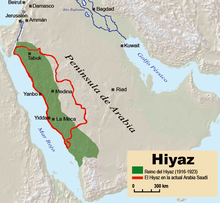History of the Jews in Arabia
The History of Jews in Arabia spans over two thousand years.
Early history

The first mention of Jews in modern-day Saudi Arabia dates back, by some accounts, to the time of the First Temple. Immigration to the Arabian Peninsula began in earnest in the 2nd century CE, and by the 6th and 7th centuries there was a considerable Jewish population in Hejaz, mostly in and around Medina, in part because of the embrace of Judaism by such leaders as Dhu Nuwas (who was very aggressive about converting his subjects to Judaism, and who persecuted Christians in his kingdom as a reaction to Christian persecution of Jews) and Abu Karib Asad.
The Hejazi Jews were mostly wine merchants and traders. At the same time, a considerable Jewish population was growing in present-day Yemen, particularly in Aden and Hadramaut, which sustained their Jewish populations until relatively recently. Jewish settlement also existed in the northern parts of the peninsula.
Tribes of Medina
There were three main Jewish tribes in Medina, forming the most important Hejazi community before the rise of Islam in Arabia. These were the Banu Nadir, the Banu Qainuqa, and the Banu Qurayza.
Other Arabian Jewish tribes in Muhammed's time:
Under Islam
After the rise of Islam in the 7th century, the Jewish population of Yemen was treated very kindly according to the Islamic hadith "There is no compulsion in religion". Jewish religion and culture survived under the Islamic civilization. Their customs, philosophies, dress, and language were, for the most part, identical to those of their Muslim neighbors. For example, they spoke standard Arabic instead of a distinctive Judeo-Arabic dialect. After the rise of Islam, the main Jewish communities in Arabia, aside from the small northern enclaves, were those in Aden and Hadramaut because most Jewish community chose to migrate to northern parts of the Middle East.
Today
As a result of Saudi Arabia's Islamic antisemitism, there is virtually no Jewish activity in Saudi Arabia today.[citation needed] Public worship of all religions but Islam is strictly forbidden. Ocassionally, Jews are allowed to enter out of necessity.
Official visits by Henry Kissinger
US Secretary of State Henry Kissinger, the first Jewish person to hold that position, came to Saudi Arabia on ten official trips on diplomatic missions on behalf of the United States[1]:
- November 8-9, 1973: Henry A. Kissinger: Riyadh: Met with King Faisal and senior Saudi officials.
- December 14, 1973: Henry A. Kissinger: Riyadh: Met with King Faisal to discuss the Middle East peace process.
- March 2, 1974: Henry A. Kissinger: Riyadh: Briefed King Faisal on the Syrian-Israeli peace process.
- May 9, 1974: Henry A. Kissinger: Riyadh: Briefed King Faisal and Foreign Minister Saqqaf on the Israeli-Syrian negotiations.
- June 14-15, 1974: Henry A. Kissinger: Jidda: Accompanied President Nixon.
- October 13, 1974: Henry A. Kissinger: Riyadh: Reviewed the Middle East peace process with King Faisal and Foreign Minister Saqqaf.
- November 6, 1974: Henry A. Kissinger: Riyadh: Discussed the Middle East peace process with King Faisal and Foreign Minister Saqqaf.
- February 15, 1975: Henry A. Kissinger: Riyadh: Briefed King Faisal on the Middle East peace process.
- March 19, 1975: Henry A. Kissinger: Riyadh: Met with King Faisal to review the Middle East peace process and bilateral.
- September 2, 1975: Henry A. Kissinger: Taif: Briefed King Khalid on the Middle East peace process.
Jewish US personnel during the Gulf War
During the Gulf War (1990-1991), when approximately a half million US military personal assembled in Saudi Arabia, and many were then stationed there, there were many Jewish US service personnel in Saudi Arabia. It is reported that the Saudi government insisted that Jewish religious services not be held on their soil but that Jewish soldiers be flown to nearby US warships[2].
See also
- Islam and antisemitism
- Jewish exodus from Arab lands
- Jews of Aden
- Jews of Hadramaut
- Religious antisemitism
References
- ^ "Saudi Arabia". U.S. Department of State. December 21, 2007.
- ^ "The Complete Idiot's Guide to Understanding Saudi Arabia". Alpha Books. December 21, 2007.
- New Standard Jewish Encyclopedia, 1992, Encyclopedia Publishing, "Aden", "Arabia", "Hadramaut"
- http://www.eretzyisroel.org/~jkatz/arabia.html
